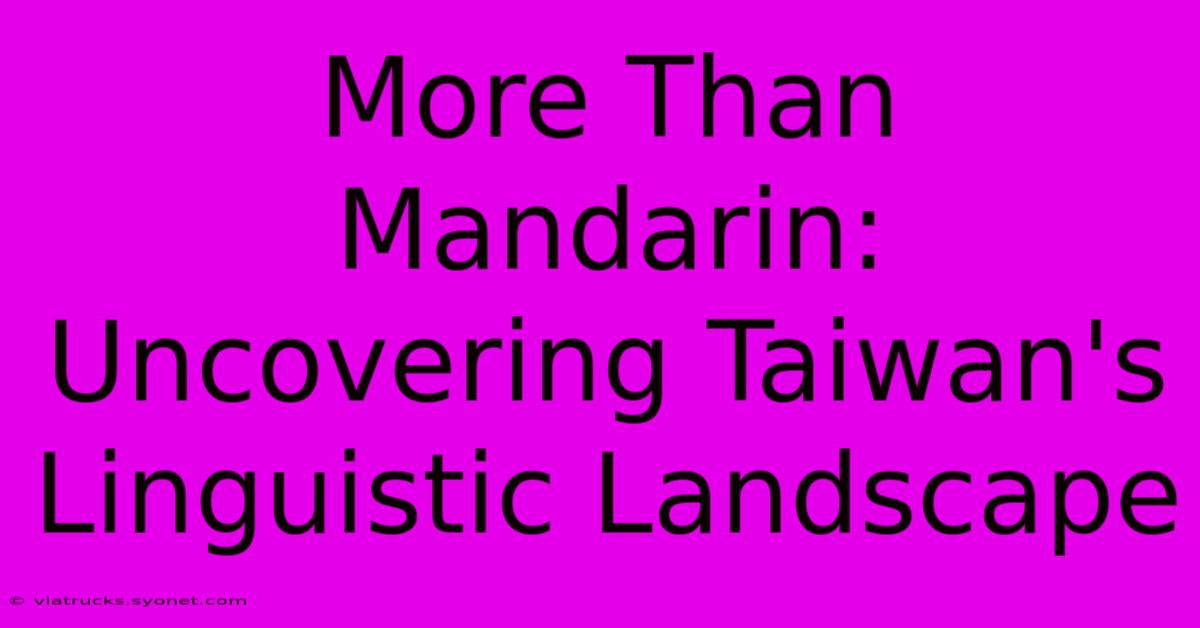More Than Mandarin: Uncovering Taiwan's Linguistic Landscape

Table of Contents
More Than Mandarin: Uncovering Taiwan's Linguistic Landscape
Taiwan, a vibrant island nation off the coast of mainland China, is often associated primarily with Mandarin Chinese. However, a closer look reveals a far richer and more complex linguistic tapestry. This article delves into the fascinating diversity of languages spoken in Taiwan, exploring their history, current status, and the ongoing efforts to preserve them. Understanding Taiwan's linguistic landscape offers a deeper appreciation for its unique cultural identity.
Beyond Mandarin: A History of Linguistic Diversity
While Mandarin (specifically, Guoyu, the standard national language) is the dominant language used in government, education, and media, Taiwan's linguistic history is far from monolithic. The island's indigenous population boasts a remarkable array of languages, belonging to the Austronesian language family. These languages, predating the arrival of Han Chinese immigrants, represent thousands of years of cultural and linguistic evolution. Estimates place the number of indigenous languages at around sixteen, although many are critically endangered.
The Arrival of Hokkien and Hakka
The arrival of significant numbers of Han Chinese immigrants, primarily from Fujian and Guangdong provinces, introduced Hokkien (Min Nan) and Hakka, two Chinese dialects that became, and remain, widely spoken. Hokkien, particularly its Taiwanese variant, holds a special place in the hearts of many Taiwanese, often viewed as a symbol of local identity and distinct from the official Mandarin. Hakka, while less prevalent than Hokkien, maintains a significant presence, particularly in certain regions.
The Current Linguistic Situation in Taiwan
Today, the linguistic landscape of Taiwan is a complex interplay between these various languages. While Mandarin serves as the lingua franca, facilitating communication across different groups, the other languages continue to play crucial roles in maintaining cultural identity and preserving heritage.
Indigenous Language Revitalization
Recognizing the importance of linguistic diversity and the threat of language loss, Taiwan has implemented various initiatives to revitalize its indigenous languages. These efforts include language immersion programs in schools, the development of language resources, and the promotion of indigenous language media. While progress has been made, these languages still face significant challenges in terms of speaker numbers and social acceptance.
The Role of Hokkien and Hakka
Hokkien and Hakka, while not officially promoted to the same extent as indigenous languages, retain strong community ties. They are spoken in homes, and continue to have an impact on local culture, cuisine, and even some forms of popular entertainment. The presence of Hokkien and Hakka influences even within Mandarin itself highlights their deep penetration in everyday life.
Challenges and Opportunities for Linguistic Preservation
The preservation of Taiwan's linguistic diversity faces ongoing challenges. The dominance of Mandarin in education and media can lead to language shift, with younger generations potentially losing fluency in their ancestral tongues. Globalization further exacerbates this trend, as the appeal of internationally recognized languages such as English may overshadow the value of preserving local languages.
However, growing awareness of linguistic diversity and the importance of cultural preservation presents significant opportunities. Government initiatives, community efforts, and increasing academic interest in Taiwan's languages all contribute to a more hopeful outlook. The increasing accessibility of language learning resources and the celebration of linguistic diversity in media also contribute to the effort.
Conclusion: A Tapestry of Tongues
Taiwan's linguistic landscape is far richer than its reputation for Mandarin alone suggests. The survival and flourishing of its indigenous languages, Hokkien, and Hakka are vital for preserving the island's unique cultural heritage. Understanding this linguistic complexity is essential for appreciating the full depth and richness of Taiwanese society. The ongoing efforts to revitalize and preserve these languages are not only linguistically significant but also critical to maintaining a vibrant and diverse cultural identity for future generations. The ongoing dialogue surrounding language policy highlights the ongoing evolution and the importance of fostering appreciation for the entirety of Taiwan's linguistic story.

Thank you for visiting our website wich cover about More Than Mandarin: Uncovering Taiwan's Linguistic Landscape. We hope the information provided has been useful to you. Feel free to contact us if you have any questions or need further assistance. See you next time and dont miss to bookmark.
Featured Posts
-
The Best Ways To Watch Super Bowl 2024 In 4 K
Feb 10, 2025
-
Sparta Vs Hradec Kralove Live Stream
Feb 10, 2025
-
Looking For The Marea De Pasiones Cast Your Search Ends Here
Feb 10, 2025
-
Bored These Nick Robinson Movies Will Save Your Night
Feb 10, 2025
-
Super Bowl Brown Siriannis Inner
Feb 10, 2025
